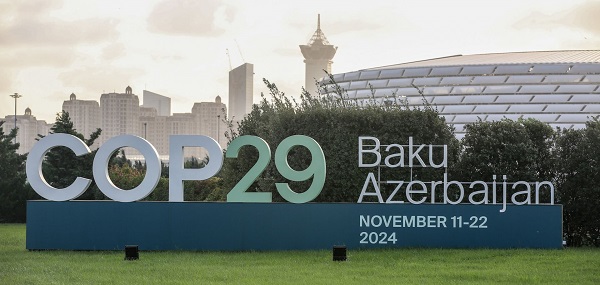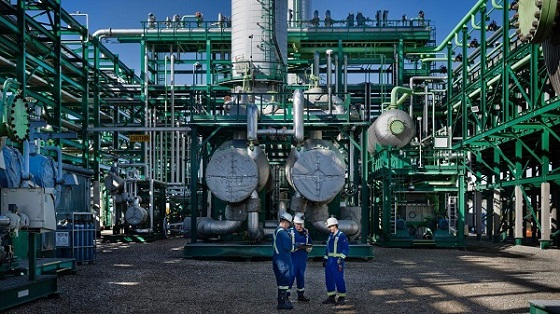Energy
COP 29 is immoral


Energy Talking Points
By Alex Epstein
COP 29 seeks net-zero, which would radically increase climate danger and ruin billions of lives
COP 29 seeks net-zero—rapidly eliminating fossil fuels—in the name of protecting us from climate danger.
In reality, net-zero would radically increase climate danger and ruin billions of lives.
People should condemn COP and embrace energy freedom.
- The COP 29 climate conference has a consistent theme: previous COPs have done an okay job of restricting fossil fuels in the name of reducing greenhouse gas emissions, but this one needs to eliminate fossil fuel use far faster so as to reach net-zero by 2050.This is 180° wrong.
- COP 29’s goal of rapidly eliminating fossil fuels to reach net-zero is deadly because:1. Fossil fuels are making us far safer from climate along with improving every other aspect of life
2. Even barely implementing COP’s net-zero agenda has been disastrous.
Fossil fuels are making us far safer from climate.
- The justification of COP 29’s net-zero agenda is that fossil fuel use is causing an escalating “climate crisis.”But if we look at the full effects of fossil fuels on climate danger, we find that overall fossil fuels have dramatically reduced climate danger.
- Myth: Climate danger is higher than ever because of fossil fuels’ CO2 emissions.Truth: We have a 98% decline in climate disaster deaths due to our enormous fossil-fueled climate mastery abilities: heating and cooling, infrastructure-building, irrigation, crop transport.¹
- Myth: Mainstream science shows that rising CO2 is an “existential threat” that will soon cause global catastrophe and then apocalypse.Truth: Mainstream science shows that rising CO2 levels will lead to levels of warming and other changes that we can master and flourish with.
- For the full story on how fossil fuels overall make us far safer from climate and will continue to do so, read this:
The climate safety denial movement
·Jan 25Read full story
Even barely implementing COP 29’s net-zero agenda has been disastrous.
- While COP 28 leaders bemoan how slow their restriction of fossil fuels in pursuit of net-zero has been, even “slow” restriction has caused a global energy crisis.
- Myth: Net-zero policies are new and exciting.Truth: Net-zero policies have caused catastrophic energy shortages even with minuscule implementation. Just by slowing the growth of fossil fuel use, not even reducing it, they have caused global energy shortages advocates didn’t warn us of.
- Minuscule net-zero policies causing huge problems:US: frequent power shortages after shutting down fossil fuel power plants.
EU: deadly fossil fuel dependence after restricting their domestic fossil fuel industry.
Poor nations: can’t afford fuel due to global restrictions.²
- If just restricting the growth of fossil fuels in a world that needs far more energy is catastrophic, what would it mean to reduce CO2 emissions by the 50% many “climate emergency” advocates want by 2030 and the 100% they want by 2050?Global misery and premature death.
Every “net zero by 2050” myth, refuted
·September 21, 2023Read full story
COP 29’s net-zero agenda harms poor nations most of all.
- The net-zero movement led by COP is particularly dangerous to Africa and other poor regions.Consider: 1/3 of the world uses wood and animal dung for heating and cooking. 3 billion use less electricity than a typical American refrigerator.
Only fossil fuels can provide the energy they need to develop.³
- Every prosperous country has developed using fossil fuels.No poor country has been able to develop to the point of prosperity without massive fossil fuel use.
Development requires energy, and fossil fuels are a uniquely cost-effective and scalable source of energy.⁴
- Fossil fuels are so uniquely good at providing low-cost, reliable energy for developing nations that even nations with little or no fossil fuel resources have used fossil fuels to develop and prosper. E.g. South Korea (83% fossil fuels), Japan (85% fossil fuels), Singapore (99% fossil fuels).⁵
- The obvious path for African development and prosperity is to use fossil fuel whenever it’s the most cost-effective option, which is most of the time, and certainly to responsibly produce the significant fossil fuel resources that exist in Africa.Yet COP tells Africa to forgo fossil fuels.
- COP 29 is fundamentally immoral because its goal of “net zero by 2050” would deprive billions of the energy they need to prosper.Good people who care about energy and human flourishing should condemn COP and net-zero can champion energy freedom instead.
The path forward: reject net-zero and embrace energy freedom.
- The path to global prosperity and increasing climate safety is energy freedom: allowing us to use all forms of energy so we are prosperous, resilient to climate danger, and in the long-term innovate new, truly cost-effective alternatives to fossil fuels.
- Rejecting net-zero and embracing energy freedom means scrapping the Paris Agreement, whose pursuit of net-zero is committing virtually all nations, including the world’s poorest, to rejecting the fossil fuels they need to prosper.
- While many at COP are saying that a US withdrawal from Paris by the next administration would be irresponsible, it is the only responsible action to take given that Paris commits us to banning most of the fossil fuels that we and our allies need.
- Rejecting net-zero, including the Paris Agreement, and embracing energy freedom requires collaboration among pro-freedom countries like the US, developing nations such as African nations, and any reasonable energy companies.
- Developing nations, above all African nations, need to reject net-zero and embrace energy freedom: the freedom to produce and use all cost-effective sources of energy—including, essentially, fossil fuels—which means rejecting all net-zero targets. Here’s a blueprint for doing it.
My Message to Leaders at African Energy Week 2023
·October 17, 2023Read full story - The energy industry and obviously the fossil fuel industry should condemn COP and its net-zero goal. Appalling, ExxonMobil and others are actually calling for the US to stay in the net-zero Paris Agreement!Here’s why this is both immoral and impractical.
The lesson of fossil fuel advocates’ failure at COP 28: stop “Arguing to 0,” start “Arguing to 100”
·December 14, 2023Read full story - Any attendee of COP 29 should thoroughly reject the conference’s “net zero by 2050” goal and instead proudly advocate for energy freedom and climate safety through climate mastery.If they do that, they have a real chance at stopping the conference from ruining the world.
Popular links
- EnergyTalkingPoints.com: Hundreds of concise, powerful, well-referenced talking points on energy, environmental, and climate issues.
- My new book Fossil Future: Why Global Human Flourishing Requires More Oil, Coal, and Natural Gas—Not Less.
- Speaking and media inquiries
“Energy Talking Points by Alex Epstein” is my free Substack newsletter designed to give as many people as possible access to concise, powerful, well-referenced talking points on the latest energy, environmental, and climate issues from a pro-human, pro-energy perspective.
Share Energy Talking Points by Alex Epstein
1
UC San Diego – The Keeling Curve
For every million people on earth, annual deaths from climate-related causes (extreme temperature, drought, flood, storms, wildfires) declined 98%–from an average of 247 per year during the 1920s to 2.5 per year during the 2010s.
Data on disaster deaths come from EM-DAT, CRED / UCLouvain, Brussels, Belgium – www.emdat.be (D. Guha-Sapir).
Population estimates for the 1920s from the Maddison Database 2010, the Groningen Growth and Development Centre, Faculty of Economics and Business at University of Groningen. For years not shown, population is assumed to have grown at a steady rate.
Population estimates for the 2010s come from World Bank Data.
2
3
Alberta
Cross-Canada NGL corridor will stretch from B.C. to Ontario

Keyera Corp.’s natural gas liquids facilities in Fort Saskatchewan. Photo courtesy Keyera Corp.
From the Canadian Energy Centre
By Will Gibson
Keyera ‘Canadianizes’ natural gas liquids with $5.15 billion acquisition
Sarnia, Ont., which sits on the southern tip of Lake Huron and peers across the St. Clair River to Michigan, is a crucial energy hub for much of the eastern half of Canada and parts of the United States.
With more than 60 industrial facilities including refineries and chemical plants that produce everything from petroleum, resins, synthetic rubber, plastics, lubricants, paint, cosmetics and food additives in the southwestern Ontario city, Mayor Mike Bradley admits the ongoing dialogue about tariffs with Canada’s southern neighbour hits close to home.
So Bradley welcomed the announcement that Calgary-based Keyera Corp. will acquire the majority of Plains American Pipelines LLP’s Canadian natural gas liquids (NGL) business, creating a cross-Canada NGL corridor that includes a storage hub in Sarnia.
“As a border city, we’ve been on the frontline of the tariff wars, so we support anything that helps enhance Canadian sovereignty and jobs,” says the long-time mayor, who was first elected in 1988.
The assets in Sarnia are a key piece of the $5.15 billion transaction, which will connect natural gas liquids from the growing Montney and Duvernay plays in B.C. and Alberta to markets in central Canada and the eastern U.S. seaboard.
NGLs are hydrocarbons found within natural gas streams including ethane, propane and pentanes. They are important energy sources and used to produce a wide range of everyday items, from plastics and clothing to fuels.
Keyera CEO Dean Setoguchi cast the proposed acquisition as an act of repatriation.
“This transaction brings key NGL infrastructure under Canadian ownership, enhancing domestic energy capabilities and reinforcing Canada’s economic resilience by keeping value and decision-making closer to home,” Setoguchi told analysts in a June 17 call.
“Plains’ portfolio forms a fully integrated cross Canada NGL system connecting Western Canada supply to key demand centres across the Prairie provinces, Ontario and eastern U.S.,” he said.
“The system includes strategic hubs like Empress, Fort Saskatchewan and Sarnia – which provide a reliable source of Canadian NGL supply to extensive fractionation, storage, pipeline and logistics infrastructure.”
Martin King, RBN Energy’s managing director of North America Energy Market Analysis, sees Keyera’s ability to “Canadianize” its NGL infrastructure as improving the company’s growth prospects.
“It allows them to tap into the Duvernay and Montney, which are the fastest growing NGL plays in North America and gives them some key assets throughout the country,” said the Calgary-based analyst.
“The crown assets are probably the straddle plants in Empress, which help strip out the butane, ethane and other liquids for condensate. It also positions them well to serve the eastern half of the country.”
And that’s something welcomed in Sarnia.
“Having a Canadian source for natural gas would be our preference so we see Keyera’s acquisition as strengthening our region as an energy hub,” Bradley said.
“We are optimistic this will be good for our region in the long run.”
The acquisition is expected to close in the first quarter of 2026, pending regulatory approvals.
Meanwhile, the governments of Ontario and Alberta are joining forces to strengthen the economies of both regions, and the country, by advancing major infrastructure projects including pipelines, ports and rail.
A joint feasibility study is expected this year on how to move major private sector-led investments forward.
Business
B.C. premier wants a private pipeline—here’s how you make that happen

From the Fraser Institute
By Julio Mejía and Elmira Aliakbari
At the federal level, the Carney government should scrap several Trudeau-era policies including Bill C-69 (which introduced vague criteria into energy project assessments including the effects on the “intersection of sex and gender with other identity factors”)
The Eby government has left the door (slightly) open to Alberta’s proposed pipeline to the British Columbia’s northern coast. Premier David Eby said he isn’t opposed to a new pipeline that would expand access to Asian markets—but he does not want government to pay for it. That’s a fair condition. But to attract private investment for pipelines and other projects, both the Eby government and the Carney government must reform the regulatory environment.
First, some background.
Trump’s tariffs against Canadian products underscore the risks of heavily relying on the United States as the primary destination for our oil and gas—Canada’s main exports. In 2024, nearly 96 per cent of oil exports and virtually all natural gas exports went to our southern neighbour. Clearly, Canada must diversify our energy export markets. Expanded pipelines to transport oil and gas, mostly produced in the Prairies, to coastal terminals would allow Canada’s energy sector to find new customers in Asia and Europe and become less reliant on the U.S. In fact, following the completion of the Trans Mountain Pipeline expansion between Alberta and B.C. in May 2024, exports to non-U.S. destinations increased by almost 60 per cent.
However, Canada’s uncompetitive regulatory environment continues to create uncertainty and deter investment in the energy sector. According to a 2023 survey of oil and gas investors, 68 per cent of respondents said uncertainty over environmental regulations deters investment in Canada compared to only 41 per cent of respondents for the U.S. And 59 per cent said the cost of regulatory compliance deters investment compared to 42 per cent in the U.S.
When looking at B.C. specifically, investor perceptions are even worse. Nearly 93 per cent of respondents for the province said uncertainty over environmental regulations deters investment while 92 per cent of respondents said uncertainty over protected lands deters investment. Among all Canadian jurisdictions included in the survey, investors said B.C. has the greatest barriers to investment.
How can policymakers help make B.C. more attractive to investment?
At the federal level, the Carney government should scrap several Trudeau-era policies including Bill C-69 (which introduced vague criteria into energy project assessments including the effects on the “intersection of sex and gender with other identity factors”), Bill C-48 (which effectively banned large oil tankers off B.C.’s northern coast, limiting access to Asian markets), and the proposed cap on greenhouse gas (GHG) emissions in the oil and gas sector (which will likely lead to a reduction in oil and gas production, decreasing the need for new infrastructure and, in turn, deterring investment in the energy sector).
At the provincial level, the Eby government should abandon its latest GHG reduction targets, which discourage investment in the energy sector. Indeed, in 2023 provincial regulators rejected a proposal from FortisBC, the province’s main natural gas provider, because it did not align with the Eby government’s emission-reduction targets.
Premier Eby is right—private investment should develop energy infrastructure. But to attract that investment, the province must have clear, predictable and competitive regulations, which balance environmental protection with the need for investment, jobs and widespread prosperity. To make B.C. and Canada a more appealing destination for investment, both federal and provincial governments must remove the regulatory barriers that keep capital away.
-

 Business18 hours ago
Business18 hours agoMost Canadians say retaliatory tariffs on American goods contribute to raising the price of essential goods at home
-

 National1 day ago
National1 day agoWomen and girls beauty pageant urges dismissal of transgender human rights complaint
-

 Alberta18 hours ago
Alberta18 hours agoCross-Canada NGL corridor will stretch from B.C. to Ontario
-

 International2 days ago
International2 days agoSupport for the Ukraine war continues because no one elected is actually in charge.
-

 Business2 days ago
Business2 days agoTrump slaps Brazil with tariffs over social media censorship
-

 Business2 days ago
Business2 days agoCBC six-figure salaries soar
-

 Business19 hours ago
Business19 hours agoB.C. premier wants a private pipeline—here’s how you make that happen
-

 Addictions2 days ago
Addictions2 days agoCan addiction be predicted—and prevented?














